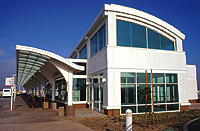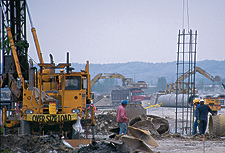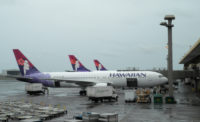 |
| (Photo courtesy of Airis Corp.) |
In the cavernous space of Worldport, a new United Parcel Service air cargo facility in Louisville, some 122 miles of conveyers whisk packages through at up to 450 ft per minute. Within 15 minutes, a piece of mail is verified, sorted and sent on its way.
Until its completion last fall, up to 1,800 construction workers at a time had been hard at work erecting 75 million lb of steel, installing 4,500 miles of fiber- optic cable and erecting the 4-million-sq-ft building. In the four years of construction on the $1-billion project, scores of contracts were let at a pace that matches the standard of the company's delivery of packages.
"We'd done smaller cargo facilities, but nothing of this size," says Ken Johnson, project manager for Indianapolis-based Hunt Construction, the construction manager for Worldport. "The building is literally built and designed around the conveyor systems. They're so complex and the clearances are so critical, that everything you do and plan for is about routing of conveyors, mounting of motors, the access to conveyors." There were 80-ft stacked conveyors, 20,000 motors, airport height restrictions on cranes and two active taxiways to cross every morning just to reach the site. Now, Hunt is looking at possible new projects both domestically and in China, says Johnson.
Building air cargo facilities may not ever be considered a glamorous or high-profile job, but those in the business know that it's far more complex and interesting than simply building big boxes in the middle of an airfield. While passenger traffic struggles in the current economic slump, wartime worries and SARS scare, air cargo is holding steady. But industry players, particularly third-party developers, are adapting to the times, as airports look to economize by offloading cargo space that isn't being utilized.
"There is still optimism that...as soon as the war subsides, we'll be able to start growing again," says Robert Kelly, consultant and former Port Authority of New York & New Jersey aviation director. "There have been cases of large airlines that had inefficient cargo business because their facilities were so large, and it caused excess costs without being utilized." Consequently, facilities will be designed to accommodate multi-tenant operations rather than one large tenant, he says.
"You are seeing a migration from single-purpose facilities," says Steven Bradford, vice president of facilities developer for Trammell Crow Co., Dallas. "Flexibility is not inherent in build-to-suit' facilities of a single tenant. It creates a hodgepodge of dysfunctional buildings in the long term...and creates demolition costs for new tenants."
Trammell Crow and Fort Worth-based design firm Carter & Burgess have been working together for years on major air cargo projects, most notably at Dallas-Fort Worth International Airport. "In the mid-90s, airports started entertaining more willingly the idea of third-party developers coming on-airport to develop projects," says David Kiel, C&B head of air cargo. With long-term leases of 25 to 40 years, "it's not a huge marketnot that many projects a year are going to happen."
But neither is it a market that will run dry, especially with an emphasis on redeveloping existing facilities for multi-tenant use, new automated technologies and security. "Because of the the state of the industry...there is more opportunity for the private sector to come into play," says Ron Factor, president of Atlanta-based Airis Corp, a third-party air facilities developer. "We're finding ourselves a preferred source for capital improvements at airports. The phone may not be ringing off the hook, but we're busier."
 |
|
AESTHETIC Cargo facilities don't have to be eyesores. (Photo courtesy of HNTB Corp.) |
GETTING BIGGER
Airis, which is about to open a $161-million, 435,000-sq-ft facility at John F. Kennedy Airport in New York City, also is launching projects in San Francisco and Stockholm. The port authority has negotiated with various private developers to design, build, operate and maintain nearly 300,000 sq ft of cargo space on 27 acres at JFK. The project, estimated at $70 million, is scheduled for completion in 2004. Airis also built a 112,000-sq-ft sorting and distribution facility in Louisville for FedEx Corp., which leased it from Airis.
UPS, which opened its Worldport in Louisville last fall, now is planning to expand its facilities in Cologne, Germany, says Jack Blaisdell, UPS program manager. "A key part is the integration between the various functionsthe information technology side and the engineering side," he says. A partnership with the Occupational Safety & Health Administration "stood the hairs of contractors on end" in Louisville but resulted in no major injuries, he adds.
To integrate more than 50 computer applications running on five different operating systems at Worldport, UPS developed a proprietary middleware tool. The tool can support more than 6,000 electronic messages per second. High-speed conveyors and "smart" labels read by overhead cameras facilitate the processing of documents, small packages, and irregular-sized shipments.
Lessons learned from Worldport will carry through to future projects, Blaisdell says. "We're making designs of new projects we think will be in place two or three years from now," he says.
With the need for flexibility in new air cargo buildings, designers are reducing the number of columns and increasing vertical space. "A lot of old buildings are built with 16-ft clearances and columns every 40 ft on center," notes Kiel. "This creates material-handling problems" because equipment drivers within the buildings are prone to hitting the columns. Now, with 10 ft x 10 ft cargo pallets and automated elevated transfer vehicles, buildings are being designed with 36-ft clear heights. And, the C&B design for DFW had 150 ft x 850 ft of column-free interior space, Kiel says. This means using stronger, light-weight steel supports for the roofs.
 |
| UPS AND AWAY United Parcel Service built $1-billion cargo facility in Louisville that is world class. (Photo courtesy of UPS) |
Ray Brimble, founder and chairman of Dallas-based Lynxs Group, says that the emphasis is on quick flow-through from trucks pulling up to loading of planes. The facilities "are not designed for storage," he says. Kiel adds that facilities also may have "build-up/break-down pits" up to 10 ft deep where pallets can be lowered into the floor so that workers can stack boxes without climbing up anything.
While air cargo buildings are unlikely to make the cover of Architectural Record, "most airports expect a building to have some aesthetic appeal," says Kiel. "A cargo facility is not a gateway terminal, but if you just put up a box, it probably won't be approved."
Brimble agrees. Lynxs Group works regularly with several architects. "We want to be good corporate citizens, and not put up eyesores," he says. Brimble says that materials for air cargo buildings have evolved from masonry or steel to tilt-wall and prefabricated metals. At Bush Intercontinental Airport, for example, "we incorporated into the tilt-up walls a design like a runway, with geometric features embossed into the sides. The roof looks curved, like a wing," he says. "It didn't cost more money, just thought."
Lynxs Group's next big project is in Anchorage, where more than 300,000 sq ft on 25 acres may be built, says Brimble. "We're looking at a very large logistics building and we are definitely building more aircraft parking positions." Bids also will be going out at year's end for the 100,000-sq-ft second phase of an intermodal air cargo facility in the Rio Grande Valley of Texas. Regional manufacturers have been struggling to improve road, airport and intermodal infrastructure to address the growing Chinese competition.
 |
|
GROWTH Third-party developer Airis built giant cargo center at JFK and is looking abroad. (Photo courtesy of Airis Corp.) |
FUTURE
The nation's new focus on security especially affects air cargo facility requirements. A report in January by the General Accounting Office said that "few changes have been made to air cargo security" and noted that most of the estimated $12 billion of air cargo shipped annually is not screened for explosives. About 22% of total air cargo is carried in passenger aircraft.
Similar to their passenger-terminal counterparts last year, air cargo facility builders and operators today are awaiting guidelines from the Transportation Security Administration on what design adjustments they will have to make to comply with forthcoming security standards. "Most certainly there will be a level of provision for screening trucks landside," says Jeff Mishler, associate vice president with Kansas City-based HNTB. Mischler is managing the master plan for Ontario, Calif.'s, airport cargo facilities. "From the building to the roads, you will have to have more room for screening and processing facilities."
At Huntsville Airport in Alabama, a state-of-the-art X-ray machine will be on line in the major cargo facility in the next two months, says Stan Hogan, director of capital improvements. "It can take a full 6 ft x 6 ft x 10 ft cargo pallet and X-ray the whole thing," he says.
But much depends on how many cargo parcels TSA will require to be screened. While every checked-in piece of luggage is screened for passenger traffic, "what actually gets implemented [for cargo] will be somewhere between every piece of cargo and where we're at today," says Mishler.
 |
| EFFICIENT Facility design calls for immediate access to trucks and planes. (Photo courtesy of Airis Corp.) |
Despite a slowdown from SARS, Asia stands out as the major source of growth opportunities for cargoand building cargo facilities. Mike Davis, FedEx senior manager of international properties and real estate, says that there are differences in the way things are done. "Normally with express cargo companies, we look at square feet of space, not cubic space. A problem as we go to airports in Asia is that there is not a lot of space in general at the airports [and] we have to get creative in using cubic space."
Trade with Asia is pumping up work at Huntsville, where a $31-million, 12,600-ft-long runway project to be completed in November will allow 747s to turn around in two hours and fuel up for direct Asia-Alabama flights. A $7-million design-build facility to open in 2005 will encourage more traffic from Asia, Europe and Mexico as well. "There is plenty of growth opportunity," says Hogan.




Post a comment to this article
Report Abusive Comment